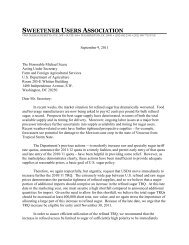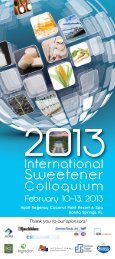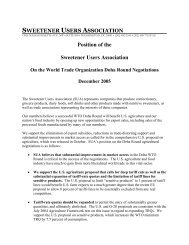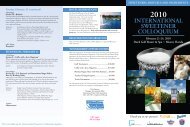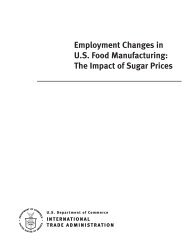SUA Letter to USDA on TRQ Increase - Sweetener Users Association
SUA Letter to USDA on TRQ Increase - Sweetener Users Association
SUA Letter to USDA on TRQ Increase - Sweetener Users Association
Create successful ePaper yourself
Turn your PDF publications into a flip-book with our unique Google optimized e-Paper software.
SWEETENER USERS ASSOCIATIONONE MASSACHUSETTS AVE. NW • SUITE 800 • WASHINGTON, DC 20001 • (202) 842-2345 • (202) 408-7763 FAXJanuary 17, 2006H<strong>on</strong>orable J.B. PennUnder Secretary for Farm and Foreign Agricultural ServicesU.S. Department of AgricultureWashing<str<strong>on</strong>g>to</str<strong>on</strong>g>n, D.C. 20250Dear Mr. Secretary:The most recent m<strong>on</strong>thly issue of the Department of Agriculture’s World Agricultural Supply andDemand Estimates (WASDE) underlines the need for additi<strong>on</strong>al supplies of sugar in the U.S. market.The <strong>Sweetener</strong> <strong>Users</strong> Associati<strong>on</strong> supports a further increase in the tariff rate quota (<strong>TRQ</strong>) forsugar, al<strong>on</strong>g with incentives <str<strong>on</strong>g>to</str<strong>on</strong>g> import the sugar promptly. Without such incentives, there is adanger of imbalances between available supplies and cane refiners’ needs as the year progresses.The need for increased imports is widely recognized. For example, The Wall Street Journal of January16, 2006, reports that the Sugar Cane Growers Cooperative of Florida “ask[ed] the <str<strong>on</strong>g>USDA</str<strong>on</strong>g> <str<strong>on</strong>g>to</str<strong>on</strong>g> allowin more foreign sugar, <str<strong>on</strong>g>to</str<strong>on</strong>g> prevent domestic shortages this seas<strong>on</strong>. Sugar producers expect <str<strong>on</strong>g>to</str<strong>on</strong>g> haveidle refining capacity this seas<strong>on</strong> and have cus<str<strong>on</strong>g>to</str<strong>on</strong>g>mers <str<strong>on</strong>g>to</str<strong>on</strong>g> supply.”The January WASDE pegs 2005/06 ending s<str<strong>on</strong>g>to</str<strong>on</strong>g>cks at 1.320 milli<strong>on</strong> short <str<strong>on</strong>g>to</str<strong>on</strong>g>ns, raw value (STRV).This is 27,000 STRV below the level of s<str<strong>on</strong>g>to</str<strong>on</strong>g>cks <strong>on</strong> September 30, 2005 – a period marked by virtuallyunprecedented tightness in available supplies. However, even this estimate may be <str<strong>on</strong>g>to</str<strong>on</strong>g>o high.Current <str<strong>on</strong>g>USDA</str<strong>on</strong>g> projecti<strong>on</strong>s rely <strong>on</strong> substantial quantities of sec<strong>on</strong>d-tier imports from Mexico, but sofar Mexican producti<strong>on</strong> is lagging last year substantially. To rely <strong>on</strong> these imports as a substitute fora further <strong>TRQ</strong> increase is <str<strong>on</strong>g>to</str<strong>on</strong>g> take risks with supply adequacy during the remainder of this year.<str<strong>on</strong>g>USDA</str<strong>on</strong>g> projecti<strong>on</strong>s also assume quota imports under the Dominican Republic-Central America FreeTrade Agreement (DR-CAFTA), but these imports are also uncertain because of delays inimplementing the agreement.The respected analytical firm Promar Internati<strong>on</strong>al believes that <str<strong>on</strong>g>to</str<strong>on</strong>g>tal supplies and ending s<str<strong>on</strong>g>to</str<strong>on</strong>g>cks arelikely <str<strong>on</strong>g>to</str<strong>on</strong>g> be lower than <str<strong>on</strong>g>USDA</str<strong>on</strong>g>’s most recent projecti<strong>on</strong>s. Specifically, Promar expects that –• The shortfall in <strong>TRQ</strong> entries will exceed <str<strong>on</strong>g>USDA</str<strong>on</strong>g>’s estimate by 40,000 STRV;
• Cane sugar producti<strong>on</strong> will be less than <str<strong>on</strong>g>USDA</str<strong>on</strong>g>’s estimate because of lower September 2006producti<strong>on</strong> in Louisiana, while beet producti<strong>on</strong> may be marginally higher, for a netestimated 13,000 STRV reducti<strong>on</strong> in <str<strong>on</strong>g>to</str<strong>on</strong>g>tal supplies; and• Based <strong>on</strong> performance <str<strong>on</strong>g>to</str<strong>on</strong>g> date, the category of “other imports,” primarily Mexican sec<strong>on</strong>dtiershipments al<strong>on</strong>g with a few other products, will likely be closer <str<strong>on</strong>g>to</str<strong>on</strong>g> 230,000 STRV than<str<strong>on</strong>g>USDA</str<strong>on</strong>g>’s 305,000 STRV.Promar also differs slightly from <str<strong>on</strong>g>USDA</str<strong>on</strong>g>’s use estimates, but the differences are marginal and largelyoffsetting. In all, Promar believes the current supply-demand balance sheet is 113,000 STRVtighter than <str<strong>on</strong>g>USDA</str<strong>on</strong>g>’s latest estimate, with ending s<str<strong>on</strong>g>to</str<strong>on</strong>g>cks just 1.207 milli<strong>on</strong> STRV. A comparis<strong>on</strong>of Promar’s balance sheet with <str<strong>on</strong>g>USDA</str<strong>on</strong>g>’s is attached <str<strong>on</strong>g>to</str<strong>on</strong>g> this letter.An ending s<str<strong>on</strong>g>to</str<strong>on</strong>g>cks level of 15.5% is, as you know, an appropriate policy goal in the view of <str<strong>on</strong>g>SUA</str<strong>on</strong>g>members. That goal would translate <str<strong>on</strong>g>to</str<strong>on</strong>g> either 1.610 or 1.612 milli<strong>on</strong> STRV, depending <strong>on</strong> whether<strong>on</strong>e uses <str<strong>on</strong>g>USDA</str<strong>on</strong>g>’s or Promar’s estimate of <str<strong>on</strong>g>to</str<strong>on</strong>g>tal use – obviously not a measurable difference. Moresignificantly, this s<str<strong>on</strong>g>to</str<strong>on</strong>g>cks goal is actually more than 100,000 STRV lower than the average s<str<strong>on</strong>g>to</str<strong>on</strong>g>ckslevel (1.738 milli<strong>on</strong> STRV) in the nine seas<strong>on</strong>s from 1996/97 through 2004/05. If <strong>on</strong>e omits fromthis average the two years 2000/01 and 2001/02, when s<str<strong>on</strong>g>to</str<strong>on</strong>g>cks were excessive, the remaining sevenseas<strong>on</strong>s saw average ending s<str<strong>on</strong>g>to</str<strong>on</strong>g>cks of 1.607 milli<strong>on</strong> STRV – almost exactly the same as the goalwe are suggesting. In other words, the use of a 15.5% s<str<strong>on</strong>g>to</str<strong>on</strong>g>cks-<str<strong>on</strong>g>to</str<strong>on</strong>g>-use goal is c<strong>on</strong>sistent with thoseyears when supplies have not been in massive surplus, and is substantially below the simple averagel<strong>on</strong>g-term level of s<str<strong>on</strong>g>to</str<strong>on</strong>g>cks. Thus, a goal of approximately 1.612 milli<strong>on</strong> STRV in ending s<str<strong>on</strong>g>to</str<strong>on</strong>g>cksis an eminently reas<strong>on</strong>able <strong>on</strong>e.To attain this goal, more supplies must be made available in a timely manner, and because ofdomestic limitati<strong>on</strong>s can <strong>on</strong>ly come through imports. <str<strong>on</strong>g>USDA</str<strong>on</strong>g>’s current WASDE would suggestadditi<strong>on</strong>al imports of 290,000 STRV (1.610 milli<strong>on</strong> STRV minus 1.320 milli<strong>on</strong> STRV). ThePromar Internati<strong>on</strong>al balance sheet would imply a need for additi<strong>on</strong>al imports of 405,000 STRV.In both cases, allowance needs <str<strong>on</strong>g>to</str<strong>on</strong>g> be made for anticipated shortfalls in filling the additi<strong>on</strong>al <strong>TRQ</strong>.Based <strong>on</strong> these c<strong>on</strong>siderati<strong>on</strong>s, <str<strong>on</strong>g>SUA</str<strong>on</strong>g> believes <str<strong>on</strong>g>USDA</str<strong>on</strong>g> should increase the <strong>TRQ</strong> by 300,000-400,000 STRV. Because we believe Promar’s estimates more closely track the current supplydemandsituati<strong>on</strong> than the January WASDE, we urge <str<strong>on</strong>g>USDA</str<strong>on</strong>g> <str<strong>on</strong>g>to</str<strong>on</strong>g> announce a <strong>TRQ</strong> increase at theupper end of this range.Announcing a quota increase is a crucial step, but we believe it is also appropriate <str<strong>on</strong>g>to</str<strong>on</strong>g> take additi<strong>on</strong>alsteps that will encourage prompt entry of the <strong>TRQ</strong>. In the currently tight world sugar market,the risk of various countries failing <str<strong>on</strong>g>to</str<strong>on</strong>g> ship their quotas is c<strong>on</strong>siderably greater than usual. Inadditi<strong>on</strong>, the expectati<strong>on</strong> of c<strong>on</strong>tinued tightness in the U.S. market may also serve as an incentive forexporting countries <str<strong>on</strong>g>to</str<strong>on</strong>g> delay shipments. In any case, U.S. cane refiners need <str<strong>on</strong>g>to</str<strong>on</strong>g> be assured of access<str<strong>on</strong>g>to</str<strong>on</strong>g> supplies in an orderly fashi<strong>on</strong>. Recognizing that <strong>TRQ</strong> allocati<strong>on</strong> is under the jurisdicti<strong>on</strong> of theOffice of the U.S. Trade Representative (USTR), <str<strong>on</strong>g>SUA</str<strong>on</strong>g> suggests that <str<strong>on</strong>g>USDA</str<strong>on</strong>g> work with its sisteragency <str<strong>on</strong>g>to</str<strong>on</strong>g> take the following steps:1. Reallocate, by April 1, any porti<strong>on</strong> of the 2005/06 <strong>TRQ</strong> that is unlikely <str<strong>on</strong>g>to</str<strong>on</strong>g> be shipped,giving sales opportunities <str<strong>on</strong>g>to</str<strong>on</strong>g> exporting countries that have sugar available. This reallocati<strong>on</strong>needs <str<strong>on</strong>g>to</str<strong>on</strong>g> occur by that period in order <str<strong>on</strong>g>to</str<strong>on</strong>g> allow adequate time for ocean shipment and inland
transport. A reallocati<strong>on</strong> very late in the quota year will not benefit U.S. refiners or theircus<str<strong>on</strong>g>to</str<strong>on</strong>g>mers (nor, for that matter, sugar-exporting countries).2. With respect <str<strong>on</strong>g>to</str<strong>on</strong>g> the increase in the 2005/06 <strong>TRQ</strong> that <str<strong>on</strong>g>SUA</str<strong>on</strong>g> has requested, take steps <str<strong>on</strong>g>to</str<strong>on</strong>g>encourage timely shipment. <str<strong>on</strong>g>SUA</str<strong>on</strong>g> supports the use of a first-come, first-servedprocedure for this quota increase. That process would assure that all the quota wouldactually be shipped, that sales would occur promptly, and that sales would be made bycountries with ample supplies of sugar. As a somewhat less desirable alternative, <str<strong>on</strong>g>SUA</str<strong>on</strong>g> couldalso support the issuance of certificates of quota eligibility (CQEs) with an expirati<strong>on</strong>date that would provide an incentive <str<strong>on</strong>g>to</str<strong>on</strong>g> ship the sugar quickly – e.g., April 30, 2006. (Thislatter mechanism would be within <str<strong>on</strong>g>USDA</str<strong>on</strong>g>’s jurisdicti<strong>on</strong> rather than USTR’s.)As always, <str<strong>on</strong>g>SUA</str<strong>on</strong>g> members appreciate your and your colleagues’ interest in the sugar market andyour desire <str<strong>on</strong>g>to</str<strong>on</strong>g> make sound, balanced policy decisi<strong>on</strong>s. We respectfully request your timelyc<strong>on</strong>siderati<strong>on</strong> of our requests and will be happy <str<strong>on</strong>g>to</str<strong>on</strong>g> supply any informati<strong>on</strong> you may need.Sincerely,EnclosureRandy Green, President



